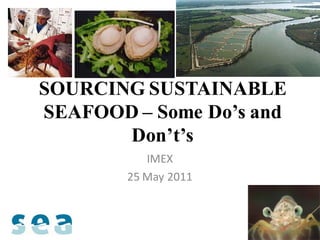Sustainable Seafood May11
- 1. SOURCING SUSTAINABLE SEAFOOD ¨C Some DoˇŻs and DonˇŻtˇŻs IMEX 25 May 2011
- 2. Mark 6:40-44
- 3. World Fish Trade: Export Value 120,000,000 - in 1000 USD - Developing countries 100,000,000 or areas Developed countries 80,000,000 or areas 60,000,000 developing 40,000,000 20,000,000 developed 0 1976 1979 1982 1985 1988 1991 1994 1997 2000 2003 2006 2009 3
- 4. Fish market trends ? Japan: long-term decline ¨C high consumption but falling: 65 kg/kaput ¨C imports fell below 3 million tons in 2007 ? USA: long-term growth, overtaking Japan as # 1 country ¨C rising population and consumption /kaput 24 kg (w/yearly variation) ? EU: long-term growth: # 1 market ¨C expanding population, stable consumption at 20 kg ¨C rising imports: e.g. catfish from Viet Nam, mussels from Chile ¨C rising import dependency ? Emerging markets: strong growth in domestic demand Brazil, Mexico, India, China, Russia, Viet Nam etc 4
- 5. Sustainability A well-managed and sustainable fishery protects the fish and the environment in which they live, whilst allowing responsible use of the species that come from it. Seafish Authority, UK
- 6. Professor Huxley, 1882 ? I believe that the cod fishery, the herring fishery, the pilchard fishery, the mackerel fishery, and probably all the great sea fisheries, are inexhaustible; that is to say, that nothing we do seriously affects the number of the fish. And any attempt to regulate these fisheries seems consequently, from the nature of the case, to be useless. ? http://aleph0.clarku.edu/huxley/SM5/fish.html
- 7. Ass Professor Boris Worm, 2006 ? Unless humans act now, seafood may disappear by 2048, concludes the lead author of a new study that paints a grim picture for ocean and human health. ? Biodiversity is a finite resource, and we are going to end up with nothing left ... if nothing changes. ? http://news.nationalgeographic.com/news/2006/11/061102- seafood-threat.html
- 8. Professor Ray Hilborn, 2009 ? Our oceans are not a lost cause. The encouraging result is that exploitation rate is decreasing in half of the ten systems we examined in detail. This means that management in those areas is setting the stage for ecological and economic recovery. We have the ability to bring overfishing under control. ? http://www.eurekalert.org/pub_releases/2009-07/cpfs- nhf072409.php
- 9. Unilever, 1996 ? Viewed challenge to their supply chain. Took a lead in encouraging more sustainable fishing practices. ? Made a commitment to purchase all our fish from sustainable sources by 2005. ? Set up the Marine Stewardship Council (MSC) with WWF. ? Since exited from MSC.
- 10. Canned Tuna to Whale So tell meˇwho does your PR?
- 11. At the Hotel Our chef (name) guarantees that our fish is delivered from one of the biggest fish manufacturers in Germany, called ˇ®Deutsche SeeˇŻ. If it is domestic fish it will be out of our region. The quality of ˇ®Deutsche SeeˇŻ is controlled regularly.
- 12. Responsibility http://www.deutschesee.de/verantwortung.html Sustainable fisheries means for us to bring economy and ecology to a common denominator. Only a sustainable fishing industry makes it possible to permanently have enjoyable food fish to bring to the plate and also to conserve resources. In order not to endanger fish stocks and marine ecosystems, we must act responsibly with the natural reserves and can no longer see the sea, than grows naturally.
- 14. What is an Ecolabel? A tag or label placed on a product that certifies that the product was produced in a sustainable, environmental manner
- 15. What is the purpose of an Ecolabel? The label allows buyers (consumer, retailer, processor) to purchase fish and fish products from well managed Fisheries (& aquaculture)
- 16. FAO Guidelines on Ecolabels ? Need to insure that these schemes are transparent, nondiscriminatory and science based. ? Guidelines contain General principles and definitions Minimum substantive requirement and criteria Procedural and institutional aspects
- 17. Wild v Aquaculture ? Overfishing ? Farming areas e.g. ? Ecosystems Mangroves ? IUU ? Farming Practices ? Fishing techniques ? Fish Feeds ? Discards/Bycatch ? Waste disposal ? Habitat damage ? Disease ? Antibiotics
- 18. So what can YOU do? ? ? Energy Efficiency Plan ? Water management Plan ? Waste management Plan ? Ensure minimal impact practices ? Source from reputable suppliers who can identify where the product has been sourced ? Introduce seafood that might not normally be served - underutilized
- 19. So what can YOU do? ? ? Look at wild and aquaculture as diferent options ? Get your staff excited by giving them information to ˇ®sellˇŻ to the consumers ? Promote the Health Benefits of eating seafood ? Push Governments to take responsibility ? Promote duties/tariffs based on sustainability ? Understand what the Ecolabel offers and get the FACTS
- 20. What NOT to do ? Buy the same species all the time ? Waste seafood ? Buy more than you need ? Fail to have your own plans and abide by them ? Fail to train your staff on all these issues ? Fail to discuss options with your seafood suppliers ? Fail to promote seafood to your clients ? Promote one Ecolabel and act on OPINIONS
- 21. Information from Australia ? EMS ¨C www.seafood.net.au/ems ? Australian Fisheries Management Authority ¨C www.afma.gov.au ? Dept of Environment and Heritage ¨C www.deh.gov.au ? Dept Agriculture Fisheries and Forestry ¨C www.daff.gov.au ? Australian Bureau of Agriculture and Resource Economics ¨C www.abare.gov.au
- 22. SEAFOOD EXPERIENCE AUSTRALIA www.australianseafood.com.au ROY PALMER CEO roy.palmer@ australianseafood.com.au Tel +61396862500 Mob +61419528733






















